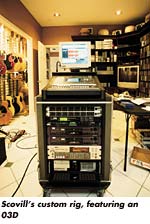
During my past few years of touring and recording, I’ve driven a few
sound companies insane with some of my interface methods. These
requests usually lead to responses such as, “Hmmm, no one ever
asked us to do that before.” Unfortunately, the schemes needed
for multitrack recording, 2-track recording, ambient press feeds, dry
audio sends and routing comparative audio to an analysis device (such
as SIA Software’s Smaart) can be extremely complex and rather
cumbersome.
SIA SMAART ANALYSIS
At some point, a light bulb came on over my head, and I assembled a
rig to handle such chores. It’s no briefcase system, but it is very
comprehensive, and the centerpiece of it is the Yamaha 03D digital
mixer. I rarely go to a gig anymore without it. Other digital mixers
could work as a substitute, but for my money, the 03D was the best
value when I designed my system. Here are some instances where this rig
has really come in handy.
RECORDING 2-TRACK
My primary use of the mixer is for analysis, comparing multiple
sources with little fuss or muss. I set up a number of “Smaart
inputs,” meaning multiple analyzer mic ins along with outs from
the main mixing console, such as L-R via a matrix, as well as solo. The
MIDI functionality on both the Smaart software and the 03D lets me send
a MIDI program change from Smaart as a function of “preset”
changes to look at various parts of the room vs. the desk audio, or
examine a soloed input in a frequency analysis mode.
AUDIO DISTRIBUTION
Need a sweet 2-track mix? Split the house’s L-R audio to two
additional 03D channels and combine it with your ambience (not
analysis) mics, add EQ or compression if desired, and route it
digitally to a 2-track recorder. As explained in my “Fix
It” tip in the December Mix, you can also perform ducking
— with key source selection — on the ambience mics, all in
the digital domain. You can even do time-offset alignment of mix and
ambient mics via the 03D’s Input Delay feature — very handy. In
my system, the 2-track audio routes digitally to a TC Electronic
Finalizer and then to dual HHB CDR-850 recorders, Tascam DA-60MkII TC
DAT and a PC with Samplitude Pro 7.0. (This computer also runs my
Smaart and ATI console control software and plays walk-in music via
Windows Media Player.)
MULTITRACK REMIXING
While on tour, you always need to get audio to destinations other
than the P.A., such as press feeds (MTV, VH-1, CNN, etc.), lawn
seating, dressing rooms, press boxes, sky boxes and more. For such
occasions, I route two stereo outputs from the 03D to dual 2-in/6-out
splitter mixers. One set has L-R audio plus ambience; the other pair is
L-R audio minus ambience. Once there, they can be set to
mono/stereo/narrow stereo and level-adjusted for the cameraman who
doesn’t realize what he’s asking for is a “mic level
output” from your console. You can also use time manipulation on
these outputs for lawn systems, delay offsets, etc.
In addition to the above 2-track scenario, I also take advantage of
the 03D’s multiple AES/EBU outs to bus the L-R audio and individual
audience mics digitally to a 64 I/O Pro Tools system. Once completed,
it then returns from Pro Tools digitally to the monitor path of the
mixer. You can then reblend audio and ambience if needed, or you can
use the Pro Tools busing to dictate what tracks arrive back at the 03D;
for instance, if you want to break the entire 64 I/O audio into 16
outputs. At that point, you can do some down-and-dirty remixes on the
03D using its automation facilities while chasing Pro Tools as a time
base. You could also mix within Pro Tools, but if you want to get your
hands on some faders, they are right at your disposal.
Finally, during the course of some tours, I’m asked to help artists
throw something down in the form of work CD/demos for songs they’re
fleshing out. When that happens, I simply unplug a couple of multicores
and head for the dressing room. Obviously, the mixer’s recall ability
is crucial in this situation, because you need to set up a
tracking/monitoring environment, store it for use during the next few
days and quickly return it to its analysis/recording duties for the
show. The 03D is wonderful for this kind of operation’s demands.
The 03D has become my “audio Swiss Army knife”: a true
routing solution in a system that requires high flexibility and
complexity. This is a situation where digital is worth its weight in
gold. I try not to leave home without it.
Robert Scovill has mixed thousands of shows and recordings for
acts such as Def Leppard, Rush, Matchbox 20 and Tom Petty. He offers an
annual three-day, hands-on workshop atwww.audioseminars.com.
